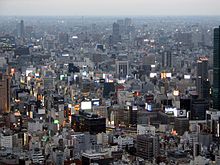




An urban area[a] is a human settlement with a high population density and an infrastructure of built environment. This is the core of a metropolitan statistical area in the United States, if it contains a population of more than 50,000.[1]
Urban areas originate through urbanization, and researchers categorize them as cities, towns, conurbations or suburbs. In urbanism, the term "urban area" contrasts to rural areas such as villages and hamlets; in urban sociology or urban anthropology it contrasts with natural environment.[citation needed]
The development of earlier predecessors of modern urban areas during the urban revolution of the 4th millennium BCE[2] led to the formation of human civilization and ultimately to modern urban planning, which along with other human activities such as exploitation of natural resources has led to a human impact on the environment.
Cite error: There are <ref group=lower-alpha> tags or {{efn}} templates on this page, but the references will not show without a {{reflist|group=lower-alpha}} template or {{notelist}} template (see the help page).
- ^ "Federal Register/Vol. 75, No. 123/Monday, June 28, 2010/Notices" (PDF). US Census Bureau. Retrieved July 22, 2023.
- ^
Morris, A.E.J. (2 December 2013) [1972]. "The Early Cities". History of Urban Form Before the Industrial Revolution (3 ed.). London: Routledge. p. 1. ISBN 9781317885146.
[...] the Bronze Age, starting between 3500 and 3000 BC [...]. During this [...] period the first urban civilizations were firmly established.